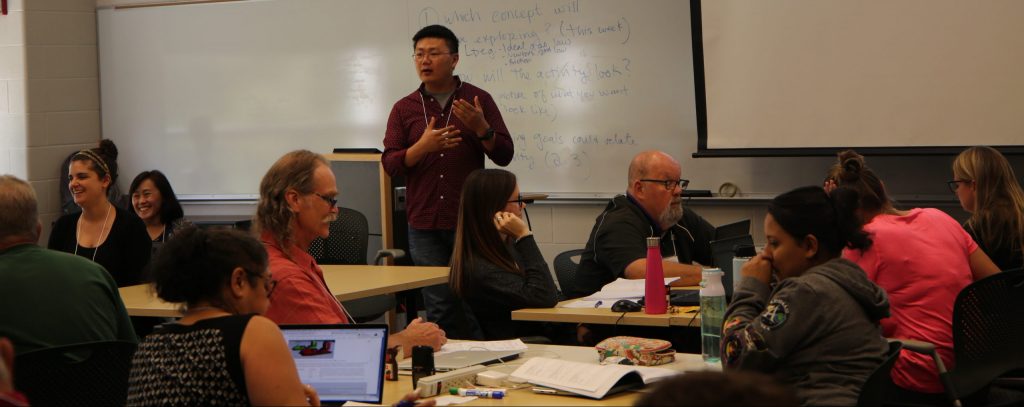
Integrating Computation in Science Across Michigan (ICSAM) is a professional development (PD) series for teachers interested in integrating computational modeling into their physics and physical science classes. The PD program is an NSF-funded project (Award No. DRL-1741575, www.nsf.gov/awardsearch/showAward?AWD_ID=1741575) where teachers learn to program and teach computational modeling to their students. The series also focuses on equity in the classroom and provides teachers with analytical tools to examine equity in their own classrooms.
The PD series begins with a five-day workshop in the summer followed by intermittent single-day events held throughout the school year. At the workshop, teachers will learn the basics of programming in VPython and design their own computational activities specifically curated for their classroom. Teachers also become familiar with the “Equity Quantified in Participation” (EQUIP, www.equip.ninja) analysis tool and use it to investigate equity in real in-class examples from other science classrooms. In follow-up single-day events, termed workdays, teachers will share their experiences, address challenges/successes encountered in the classroom, and form action plans for future iterations of computational interventions. Throughout the year, teachers are also provided opportunities to share their work with the broader teaching community at local and national conferences.
SCECH credits are provided for teachers participating in ICSAM PD events.
ICSAM Approach to Teaching Computation
The programming language that teachers use for all computational modeling activities is VPython. This language is a specialized form of the Python coding language which makes use of the “Visual” 3D graphics module. The language is particularly designed for modelling objects and events in a 3D environment. For this reason, VPython is well suited to simulate motion, collisions, and other spatial features that are commonplace in the classroom. Accordingly, visual animation is emphasized as an important way of helping students learn physics. The ICSAM program employs online platforms (like Glowscript and Trinket.io websites) for all computational work. These platforms make it easy for teachers and students to create, save, and share their code with their collaborators.
The ICSAM model makes use of “minimally working programs” (MWPs) to simplify the more difficult aspects of coding, provide scaffolding for students, and to keep the focus on physics even in during computational activities. At first, MWPs exist as a functional computer code that will run without an error and model some aspect of a physics phenomenon. This serves as a jumping off point for students. Scaffolding can be further augmented by adding comments to the code or providing a worksheet to guide students through the beginning of an activity. Minimally working programs are beneficial because students can start activities by interacting with the physics immediately, while not being slowed down with creating a computer program from scratch. Usually, MWPs will start off as a simulation that runs without an error but somehow models the physics incorrectly. As a simple example, students may be given a model that does not have any value for the net force yet, and students will have to add an equation for the net force that references the pre-existing code. In some cases, teachers may have provided a MWP that has a simple error embedded to provide students experience with debugging. By the end of most activities, students will have modified the MWPs to implement physics equations, model phenomena, and change values in their code to rapidly test and predict the outcomes of different physical scenarios.
A key distinction that separates the ICSAM approach to computational integration is that curricular design is solely at the teacher’s discretion. There is no set curriculum that the workshop intends to establish in every participant’s classroom. In other words, the ICSAM PD experience is not a prescriptive intervention for teachers to instantly implement in their classrooms. Rather, each instructor decides how thoroughly computation will be integrated in their respective environment. We feel that this approach is necessary because instructors tend to have very different levels of programming and teaching experience, different intentions for implementing computation and different learning goals for their classrooms. For someone with little or no experience coding, seeing a fully working script can be very intimidating. For teachers in this position, it is essential that we do not exacerbate this by moving too fast. In addition, while we don’t want computational integration to be too daunting for newcomers, we also don’t want it to be too simplistic for those experienced with computation. Therefore, we take a teacher-centered curriculum approach, and we support the teachers with the decisions they make around their curriculum. By using this approach, each individual teacher’s confidence and overall comfort with learning to code are the primary concern, and this facilitates successful workshop activities.
Another focus of the ICSAM PD series is to promote equity around computational work in the classroom. Since working in groups is messaged heavily in the workshop, equitable participation is an important factor to keep in mind for early learners of computing. To study equity in the classroom, teachers are given experience with EQUIP (Equity QUantified In Participation), a software designed to synthesize data around equity in classroom activities. Workshop attendees are trained to use EQUIP to create a student roster, choose the social markers and aspects of classroom discourse they want to track, and collect and analyze data to evaluate. This allows teachers to make sure that their classroom activities (especially group-based activities) are equitable. This is a healthy collaboration because these teachers are in the process of designing new curriculum that is centered on group-based computational activities, and this provides them with a means of evaluating the equity of these activities as early as their first implementation.